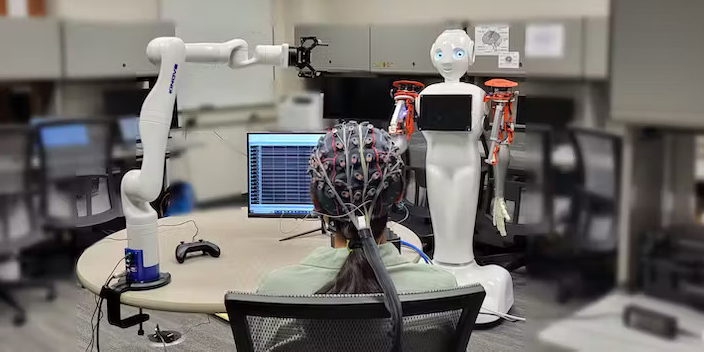
Brain-computer interfaces could let people control robotic arms by thought alone. Ramana Vinjamuri, CC BY-ND
UMBC has more than 60 faculty and senior research staff associated with the UMBC Center for Artificial Intelligence, whose research includes work on AI-related problems and techniques. They come from departments, centers, and institutes across UMBC and represent many disciplines.
- Tülay Adali (CSEE): machine learning for signal processing and bioinformatics
- Diane Alonso (Psychology): Generative AI Pedagogy, Human-Centered AI, Human-Computer Interaction, intersection of AI and cognitive processes
- Nilanjan Banerjee (CSEE): smart cyber-physical systems, robotics, manufacturing
- Justin Brooks (CSEE): computational and behavioral neuroscience, medical applications of AI
- Chien I. Chang (CSEE): remote sensing, image processing
- Ansu Chatterjee (Math & Statistics): Foundations of data sciences, ethical AI, Bayesian and conditional inference, digital twins and personalized healthcare, climate analytics
- Keke Chen (CSEE): Privacy and security of AI, data mining/machine learning, and distributed systems
- Lujie (Karen) Chen (IS): multimodal learning analytics, machine learning, data science, medical informatics
- Zhiyuan Chen (IS): data mining, adversarial learning, semantic information
- Jim Clavin (Hilltop): AI for healthcare informatics, byzantine fault tolerance, knowledge graphs, generative AI
- Mohammad ‘Khash’ Donyaee (CSEE, Lecturer): AI, machine learning
- Abhijit Dutt (CSEE, Professor of Practice): data science, AI, machine learning
- Don Engel (CSEE, VP Research): visualization, computer vision, NLP
- Frank Ferraro (CSEE): natural language understanding (NLP), machine learning
- Tim Finin (CSEE): Knowledge graphs, knowledge representation and reasoning, human language technology, AI
- James Foulds (IS): socially conscious machine learning and artificial intelligence
- Manas Gaur (CSEE): Knowledge graphs and machine learning for NLP, recommender systems, and computational social data science
- Md Osman Gani (IS): explainable AI, ubiquitous computing, indoor localization, healthcare, and human activity recognition
- Aryya Gangopadhyay (IS): data mining, healthcare analytics
- Matthias Gobbert (Math): Machine learning, big data applications in science & engineering, parallel algorithms for computing clusters
- Ankit Goel (ME): control systems, data-driven learning for complex control systems.
- Tejas Gokhale (CSEE): computer vision, machine learning, reasoning
- Milton Halem (CSEE): Big data for climate, quantum computing for AI
- Morgan Henderson (Hilltop): predictive modeling and causal inference using administrative health data for populations in Maryland
- Riadul Islam (CSEE): Robust, secured IC design for neuromorphic computing and machine learning applications
- Vandana Janeja (IS): data science, data mining, anomaly detection
- Ben Johnson (CSEE, Lecturer): AI, NLP, machine learning
- Tyler Josephson (CBEE): AI, logic, machine learning, molecular simulation, applications in chemical and environmental engineering
- Anupam Joshi (CSEE, Dean): AI for cybersecurity & cyber-physical systems, Web/text analysis, semantic web, neural networks
- Karuna Joshi (IS): data science, knowledge graphs, regulatory and legal AI, data security and privacy compliance, cloud computing
- Kostas Kalpakis (CSEE): data science, algorithms for knowledge graphs, machine learning
- George Karabatis (IS): data science, semantic information integration, machine learning
- Seung-Jun Kim (CSEE): machine learning, applications to communications, future power systems, and big data analytics
- Andrea Kleinsmith (IS): affective computing and human-computer interaction
- Yasmine Kotturi (IS): human-centered AI, Human-Computer Interaction.
- Dong Li (CSEE): Wireless Sensing, Mobile Computing, Wearable Sensing, Multi-model Sensing, Smart Health
- Chenchen Liu (CSEE): high-performance computing for AI, machine learning
- Christine Mallinson (LLC): identifying linguistic bias and misinformation
- Christopher Marron (CSEE), Professor of Practice): machine learning, data science
- Lara Martin (CSEE): Human‑centered AI, computational creativity, language understanding, neuro-symbolic methods, speech processing, affective computing, conversational agents
- Cynthia Matuszek (CSEE): robotics, human-robot interaction, machine learning, NLP, cybersecurity
- Eric Millikin (Visual Arts): AI and art, virtual reality
- Charles Nicholas (CSEE): machine learning and data science for malware detection, intelligent information systems
- Thu Nguyen (Math): machine learning, stochastic approximation
- Timothy Nohe (Visual Arts): natural language image, video & music generation; ethical and fair use of these tools, visual biases & tropes in AI image generation.
- Tim Oates (CSEE): machine learning, AI
- Patti Ordóñez (IS): machine learning, data mining, and visualization to multivariate time series analysis, clinical informatics, biomedical data science
- Shimei Pan (IS): NLP, machine learning, data mining
- Sanjay Purushotham (IS): machine learning, data science, computer vision and its applications to healthcare & bio-informatics, social network analysis, and multimedia data mining
- Nirmalya Roy (IS): machine learning for mobile, pervasive, and sensor computing, autonomous systems
- Jinglai Shen (Math): machine learning, optimization
- John Schumacher (Sociology, Anthropology, and Public Health): generative AI, pedagogy, gerontology, healthcare delivery
- Ergun Simsek (CSEE): machine learning for applications in photonics and electromagnetics
- Jennifer Sleeman (CSEE): NLP, document understanding, machine learning
- Kai Sun (IS): optimization, graph-based models and algorithms, and machine learning, with a focus on resource planning in healthcare and manufacturing systems
- KMA Solaiman (CSEE): machine learning, multimodal data management; applications to data discovery, multimodal information retrieval, uncertainty management, recommender systems, NLP, video feature extraction
- Houbing Herbert Song (IS): AI/machine learning/big data analytics for cyber-physical systems/IoT, cybersecurity, and privacy
- Eric J. Stokan (Political Science): NLP, ML, and LLMs for the social sciences
- Ramana Vinjamuri (CSEE) brain-computer interfaces, machine learning, signal processing
- Jianwu Wang (IS): data science for climate and manufacturing
- Mohamed Younis (CSEE): Machine learning for communications, networks, and embedded systems
- Ali Yousuf (CSEE): AI, machine learning, and data science for healthcare applications
- Meilin Yu (ME): Computational fluid dynamics, scientific machine learning, high-performance computing
- Roberto Yus (CSEE): knowledge representation and reasoning, knowledge graphs, IoT, privacy, semantic data management
- Rebecca Williams (CSEE): immersive media, data visualization, computer vision, computer graphics, brain-computer interface, wearable sensor technology, imaging, and remote sensing